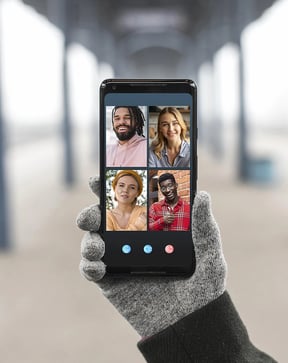Analysis is a very important activity that can determine the success of a project implementation. Through this stage, it is possible to clearly identify what are the real needs of users, what are the problems that most afflict them and what are their expectations to consider a tool to be useful.
The implementation of an Intranet is not exempt from an analysis or "discovery" phase, in which face-to-face work sessions are normally scheduled with the different groups of users who will have access to the Intranet.
Face-to-face interaction with users is very valuable as it allows us to establish a relationship with them and have effective communication. Unfortunately, due to the health emergency that we are currently experiencing, it is not easy to carry out face-to-face dynamics.
Even so, there is no impediment to successfully carry out a discovery phase in a remote way, since there are endless tools and communication channels that allow a group of users to interact remotely.
A few months after the COVID-19 contingency began, Definity First gladly took on the challenge of conducting its first “Remote Discovery Phase”. By doing so, we faced a new situation where we had to define an execution strategy that suited our remote audience.
We started by reviewing each one of the activities to decide the best way to do it remotely and we established times, since very long remote sessions tend to tire users. Then we concentrated on validating support tools to carry out online collaboration dynamics and finally we integrated the sessions into a work agenda.
In general, we had good results and it was possible to obtain valuable information from the users, capturing their attention, as well as their collaboration to perform group activities. We continue working to anticipate unforeseen events such as technological or organizational failures.
This first experience left us with many lessons learned and that we want to share with you.
Top ten recommendations to carry out a successful discovery phase
- Research the audience
It is important to know the audience in advance, investigate their age ranges, as well as their profiles or functions within the company, as this will help you decide which is the best strategy to carry out the sessions.
It is not the same to have an audience with people between 20 and 30 who are used to different apps and collaboration tools, than with people over 40 who prefer to use more traditional communication channels and are not so related to the most recent applications.
- Research the audience's connection preferences
Check if there’s any preference in the use of any remote session platform (MS Teams, Zoom, GoTo Meeting, etc.) or if there’s any limitation in the use of any of them; Try to align with the preferences of the audience as they will feel more comfortable using a tool they already know, plus you will ensure that people will not have problems connecting.
- Look for easy-to-use and accessible tools
Evaluate several alternatives for online collaboration tools that you can use as support to carry out the activities of the sessions. Consider that they are easy to use and to access, as well as they are free, or the users have a license to use them.
- Give clear instructions
At the beginning of each activity, provide clear instructions to the audience, in which you include the objective, what they must do and the time available. If possible, keep these instructions visible during the activity so that users can check them at any time.

- Motivate the audience to participate
Look for activities that will help you collect the information you need and that invite the user to collaborate, this way the sessions will be more interactive, and you can have more possibilities to capture the audience's attention.
- Pilot the sessions
Take the time to simulate a scenario like the one you will have in real sessions to be able to evaluate the tools, as well as to identify possible problems in advance. Invite a group of collaborators to join a remote test session, in which you carry out the planned activities with them and you can take note on the behavior of both the tool and the audience.
- Avoid scheduling long sessions
Review the activities that will be included in your sessions and create an agenda that will allow you to estimate an approximate duration for each session. If the time is more than 2 hours, consider a break of some minutes in the session or if necessary, split the session, long sessions can be tiring for the audience and you can lose their interest.
- Invite small groups of users per session
Create small groups for each session, so everyone can participate and have enough time to do so, this way you can give each one the right attention.
- Share the agenda and relevant information in advance
When sending the invitations be sure to include the agenda for each session, and if necessary, ask the audience to prepare with specific information before the session. If any activity requires people to answer certain questions or share information, you can send it in advance so they can analyze it and during the session, get more out of the time available.
- Have a backup plan to lead the sessions
Make sure that at least 2 members of your team know the activities or topics that must be covered in each session, so in case of any problem with the person responsible for directing a session, another can take its place. We must not rule out that the person responsible for the session could have an access problem or an unstable Internet connection, so it is important to show that the entire team is ready to continue a session.


